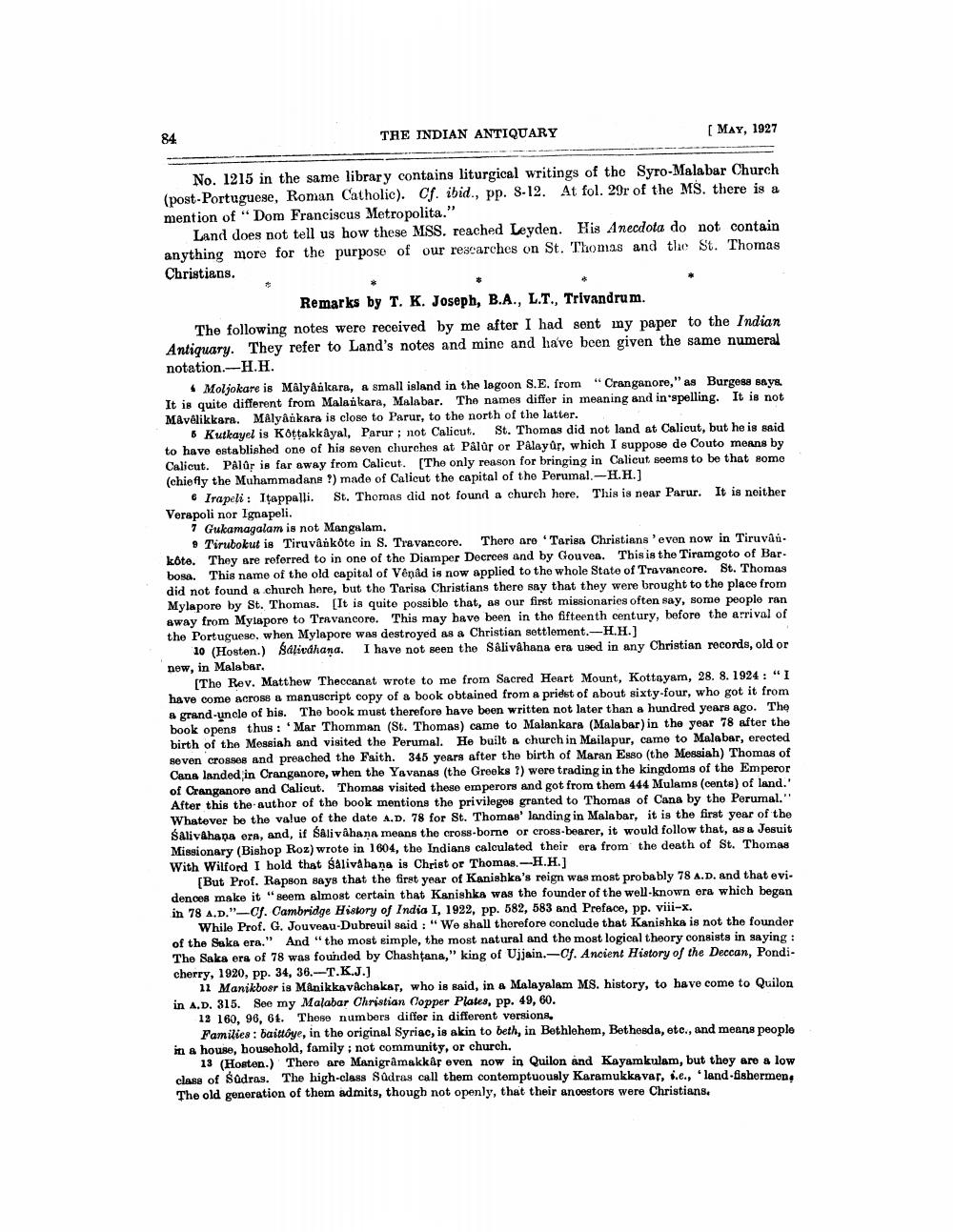________________
THE INDIAN ANTIQUARY
[MAY, 1927
No. 1215 in the same library contains liturgical writings of the Syro-Malabar Church (post-Portuguese, Roman Catholic). Cf. ibid., pp. 8.12. At fol. 29r of the MS. there is a mention of "Dom Franciscus Metropolita."
Land does not tell us how these MSS. reached Leyden. His Anecdota do not contain anything more for the purpose of our researches on St. Thomas and the St. Thomas Christians.
Remarks by T. K. Joseph, B.A., L.T., Trivandrum. The following notes were received by me after I had sont my paper to the Indian Antiquary. They refer to Land's notes and mine and have been given the same numeral notation.-H.H.
Moljokare is MAlyankara, a small island in the lagoon S.E. from "Cranganore," as Burgesa saya. It is quite different from Malaikara, Malabar. The names differ in meaning and in spelling. It is not M&vélikkara. Mâlyankara is close to Parur, to the north of the latter.
6 Kutkayel is Kottakkâyal, Parur; not Calicut. St. Thomas did not land at Calicut, but he is said to have established one of his seven churches at Palūs or Palayûr, which I suppose de Couto means by Calicut. Palûr is far away from Calicut. (The only reason for bringing in Calicut seems to be that some (chiefly the Muhammadana ?) made of Calicut the capital of the Porumal.-H.H.]
6 Irapeli: Itappalli. St. Thomas did not found a church hore. This is near Parur. It is neither Verapoli nor Ignapeli.
7 Gukamagalam is not Mangalam.
9 Tirubokut is Tiruvânkote in S. Travancore. There are Tarisa Christians 'even now in Tiruvâú. kote. They are referred to in one of the Diamper Decrees and by Gouves. This is the Tiramgoto of Bar. bosa. This name of the old capital of Vêņåd is now applied to the whole State of Travancore. St. Thomas did not found a church here, but the Tarisa Christians there say that they were brought to the place from Mylapore by St. Thomas. [It is quite possible that, as our first missionaries often say, some people ran away from Mylapore to Travancore. This may have been in the fifteenth century, before the arrival of the Portuguese, when Mylapore was destroyed as a Christian settlement.-H.H.]
10 (Hosten.) Salidhana. I have not seen the Salivahana era used in any Christian records, old or new, in Malabar.
[The Rev. Matthew Theccanat wrote to me from Sacred Heart Mount, Kottayam, 28. 8. 1924: "I have come across a manuscript copy of a book obtained from a priest of about sixty-four, who got it from & grand-uncle of his. The book must therefore have been written not later than a hundred years ago. The book opens thus : Mar Thomman (St. Thomas) came to Malankara (Malabar) in the year 78 after the birth of the Messiah and visited the Perumal. He built a church in Mailapur, came to Malabar, erected seven crosses and preached the Faith. 345 years after the birth of Maran Esso (the Messiah) Thomas of Cana landed in Cranganore, when the Yavanas (the Greeks ?) were trading in the kingdoms of the Emperor of Cranganore and Calicut. Thomas visited these emperors and got from them 444 Mulams (cents) of land.' After this the author of the book mentions the privileges granted to Thomas of Cana by the Perumal." Whatever be the value of the date A.D. 78 for St. Thomas' landing in Malabar, it is the first year of the Salivahana era, and, if Salivahana means the cross-bomo or cross-bearer, it would follow that, as a Jesuit Missionary (Bishop Roz) wrote in 1604, the Indians calculated their era from the death of St. Thomas With Wilford I hold that Saliva hana is Christ or Thomas.-H.H.]
[But Prof. Rapson says that the first year of Kanishka's reign was most probably 78 A.D. and that evi. dences make it "seem almost certain that Kanishka was the founder of the well-known era which began in 78 A.D." _o. Cambridge History of India I, 1922, pp. 582, 583 and Preface, pp. viii-x.
While Prof. G. Jouveau-Dubreuil said: "We shall therefore conclude that Kanishka is not the founder of the Saks era." And "the most simple, the most natural and the most logical theory consists in saying: The Saks era of 78 was founded by Chashtana," king of Ujjain.-of. Ancient History of the Deccan, Pondicherry, 1920, pp. 34, 36.--T.K.J.)
11 Manikboer is Manikkavichakar, who is said, in a Malayalam MS. history, to have come to Quilon in A.D. 315. See my Malabar Christian Copper Plates, pp. 49, 60.
13 160, 96, 61. These numbers differ in different versions
Families : baittoye, in the original Syriac, is akin to beth, in Bethlehem, Bethesda, etc., and means peoplo in a house, household, family, not community, or church,
13 (Hosten.) There are Manigramakkar oven now in Quilon and Kayamkulam, but they are a low class of Sodras. The high-class Sadras call them contemptuously Karamukkavar, i.e., land-fishermen, The old generation of them admits, though not openly, that their ancestors were Christianse




